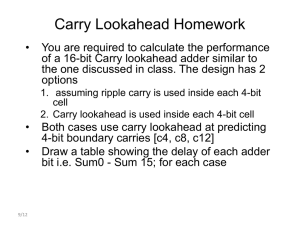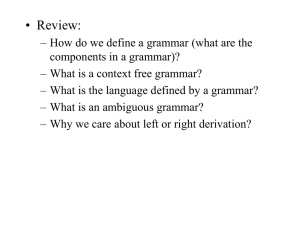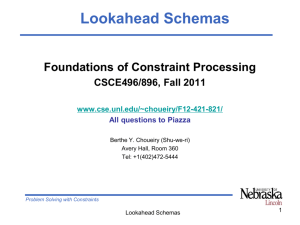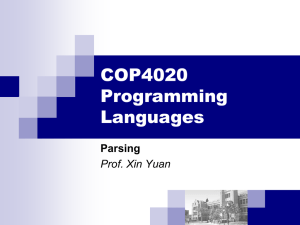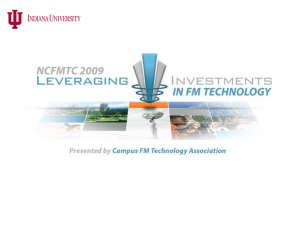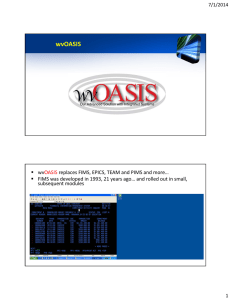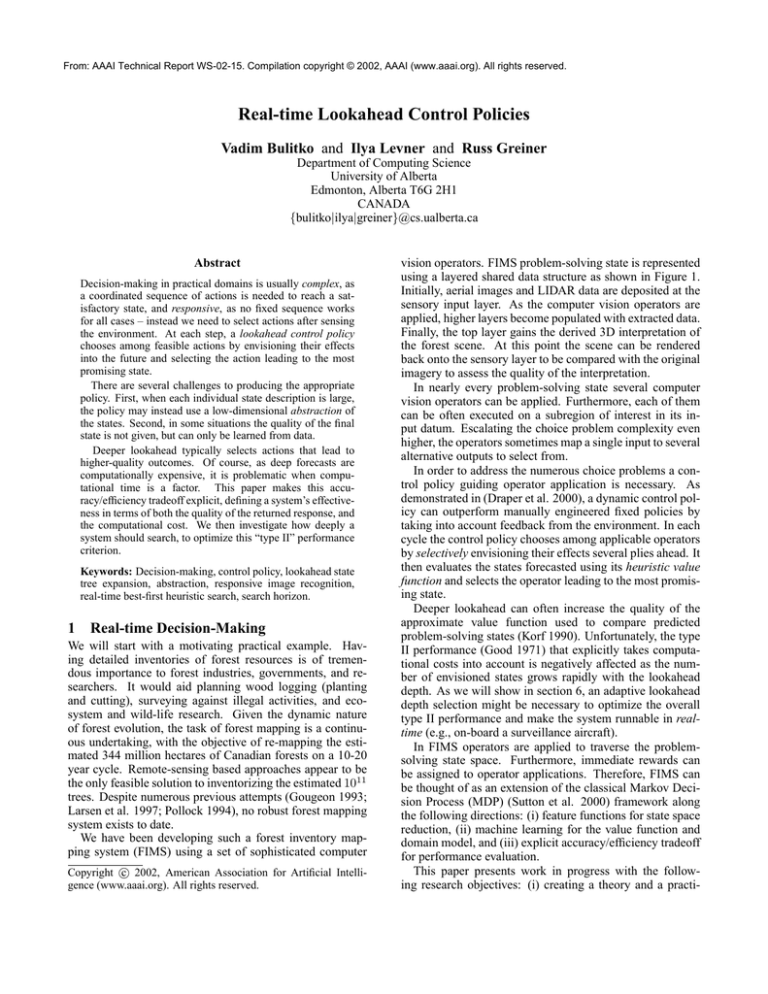
From: AAAI Technical Report WS-02-15. Compilation copyright © 2002, AAAI (www.aaai.org). All rights reserved.
Real-time Lookahead Control Policies
Vadim Bulitko and Ilya Levner and Russ Greiner
Department of Computing Science
University of Alberta
Edmonton, Alberta T6G 2H1
CANADA
{bulitko|ilya|greiner}@cs.ualberta.ca
Abstract
Decision-making in practical domains is usually complex, as
a coordinated sequence of actions is needed to reach a satisfactory state, and responsive, as no fixed sequence works
for all cases – instead we need to select actions after sensing
the environment. At each step, a lookahead control policy
chooses among feasible actions by envisioning their effects
into the future and selecting the action leading to the most
promising state.
There are several challenges to producing the appropriate
policy. First, when each individual state description is large,
the policy may instead use a low-dimensional abstraction of
the states. Second, in some situations the quality of the final
state is not given, but can only be learned from data.
Deeper lookahead typically selects actions that lead to
higher-quality outcomes. Of course, as deep forecasts are
computationally expensive, it is problematic when computational time is a factor. This paper makes this accuracy/efficiency tradeoff explicit, defining a system’s effectiveness in terms of both the quality of the returned response, and
the computational cost. We then investigate how deeply a
system should search, to optimize this “type II” performance
criterion.
Keywords: Decision-making, control policy, lookahead state
tree expansion, abstraction, responsive image recognition,
real-time best-first heuristic search, search horizon.
1
Real-time Decision-Making
We will start with a motivating practical example. Having detailed inventories of forest resources is of tremendous importance to forest industries, governments, and researchers. It would aid planning wood logging (planting
and cutting), surveying against illegal activities, and ecosystem and wild-life research. Given the dynamic nature
of forest evolution, the task of forest mapping is a continuous undertaking, with the objective of re-mapping the estimated 344 million hectares of Canadian forests on a 10-20
year cycle. Remote-sensing based approaches appear to be
the only feasible solution to inventorizing the estimated 1011
trees. Despite numerous previous attempts (Gougeon 1993;
Larsen et al. 1997; Pollock 1994), no robust forest mapping
system exists to date.
We have been developing such a forest inventory mapping system (FIMS) using a set of sophisticated computer
c 2002, American Association for Artificial IntelliCopyright gence (www.aaai.org). All rights reserved.
vision operators. FIMS problem-solving state is represented
using a layered shared data structure as shown in Figure 1.
Initially, aerial images and LIDAR data are deposited at the
sensory input layer. As the computer vision operators are
applied, higher layers become populated with extracted data.
Finally, the top layer gains the derived 3D interpretation of
the forest scene. At this point the scene can be rendered
back onto the sensory layer to be compared with the original
imagery to assess the quality of the interpretation.
In nearly every problem-solving state several computer
vision operators can be applied. Furthermore, each of them
can be often executed on a subregion of interest in its input datum. Escalating the choice problem complexity even
higher, the operators sometimes map a single input to several
alternative outputs to select from.
In order to address the numerous choice problems a control policy guiding operator application is necessary. As
demonstrated in (Draper et al. 2000), a dynamic control policy can outperform manually engineered fixed policies by
taking into account feedback from the environment. In each
cycle the control policy chooses among applicable operators
by selectively envisioning their effects several plies ahead. It
then evaluates the states forecasted using its heuristic value
function and selects the operator leading to the most promising state.
Deeper lookahead can often increase the quality of the
approximate value function used to compare predicted
problem-solving states (Korf 1990). Unfortunately, the type
II performance (Good 1971) that explicitly takes computational costs into account is negatively affected as the number of envisioned states grows rapidly with the lookahead
depth. As we will show in section 6, an adaptive lookahead
depth selection might be necessary to optimize the overall
type II performance and make the system runnable in realtime (e.g., on-board a surveillance aircraft).
In FIMS operators are applied to traverse the problemsolving state space. Furthermore, immediate rewards can
be assigned to operator applications. Therefore, FIMS can
be thought of as an extension of the classical Markov Decision Process (MDP) (Sutton et al. 2000) framework along
the following directions: (i) feature functions for state space
reduction, (ii) machine learning for the value function and
domain model, and (iii) explicit accuracy/efficiency tradeoff
for performance evaluation.
This paper presents work in progress with the following research objectives: (i) creating a theory and a practi-
…
3D Scene Interpretation
ReconsReconstructor 1
ReconsReconstructor n
Canopy Clusters
Grouper 1
…
Grouper n
Labeler 1
…
Labeler n
Projector
Probabilistic Maps
Extracted Features
Feature
Extractor 1
…
Feature
Extractor n
Sensory Input
Figure 1: Forest Inventory Mapping System (FIMS) is based on a layered data representation. Raw sensory data such as aerial
images are deposited at the bottom layer. As various computer vision operators are applied higher layers become populated
with derived data. The output of the system is formed at the top layer and is then projected back into 2D for quality assurance. In
addition to deciding among operators (e.g., feature extractor #5 vs. feature extractor #12) their inputs often need to be decided
on as well (e.g., image subregion #1 vs. image subregion #87).
cal implementation of an adaptive lookahead depth selection module, (ii) studying machine learning methods for
value function and domain model approximation within the
large-scale FIMS application, (iii) comparing the adaptive
envisionment-based control policy for FIMS with traditional
hand-crafted scene interpretation strategies.
The rest of the paper is organized as follows. Section 2
describes the challenges we faced in producing this system
– many due to our efforts to make the real-world system,
with its mega-byte state information, run efficiently. We
then (section 3) present a best-first lookahead control policy guided by an approximate MDP value function. The
section discusses its advantages over optimal goal-seeking
algorithms such as A* as well as the challenges in the form
of value function inaccuracies. Section 4 discusses type II
optimality which explicitly combines performance quality
and computational time and poses the specific problem we
will address in this paper: automatically determining the appropriate depth of the search. Section 5 then provides an
empirical study to help us address this problem. Here we
first present the artificial ”grid world” domain, and explain
why this domain is rich enough to capture the challenges of
the FIMS system, while remaining sufficiently constrained
that we can obtain precise numbers. We then draw several
important conclusions in section 6 and consider related research in section 7.
2
Challenges
Like many real-world systems, the FIMS control policy is
faced with several formidable challenges including:
Ill-defined goal states. In FIMS, a goal system state contains an accurate interpretation of the forest scene observed. Unfortunately, such a state is impossible to recognize since the sought forest maps are typically unknown.
The lack of recognizable goal states means that we cannot
use optimal goal-searching algorithms such as A*, IDA*,
RBFS, etc. (Korf 1990).
Partial state observability. Raw states are often enormous
in size – FIMS requires on the order of 107 bytes to describe a single problem-solving state. Thus, the raw state
space is infeasible to handle. A common remedy is to employ a state abstraction function F that maps large raw
states to smaller abstracted states specified via extracted
feature values. ADORE (Draper et al. 2000) uses feature functions to reduce multi-megabyte raw images to a
handful of real-valued parameters such as the average image brightness or edge curvature. As a result, the control
policy operates over the abstracted state space which usually requires extensions beyond the classical MDP.
Value function inaccuracies. In order to help select an operator to apply we need a value function which maps a
problem-solving state to a numeric score, thereby setting
a preference relation over the set of reachable states. It is
typically defined as the reward the system would get from
that state on, by acting optimally. If the control policy
had access to the actual optimal value function V ∗ (Sutton et al. 2000) it would be able to act optimally in a
simple greedy fashion. Unfortunately, as the true value
function is usually unavailable, we use an approximation
Ve ∗ (denoted with a tilde). Various inaccuracies in the approximate V ∗ often lead to sub-optimal action choices
and force back-tracking (Draper et al. 2000). Section 3
describes several kinds of value function errors in more
detail.
Limited decision-making time. Value function inaccuracies can often be compensated by carrying out a deeper
lookahead (Hsu et al. 1995). On the other hand, the run
time of state expansion can be exponential in the number of plies, thereby severely limiting the depth possible
under time constraints (Korf 1990). This trade-off becomes especially pressing if real-time performance is desired (e.g., on-board a surveillance aircraft).
Inaccurate domain models. Advanced computer vision
operators involving EM algorithms (Cheng et al. 2002)
can take hours to compute on large images. The exponential number of operator applications often needed for the
lookahead makes the actual operators unusable for envisionment. Thus, approximate versions of such operators
comprising the domain model are employed for the lookahead. Consequently, such simplified models are inaccurate and, therefore, unable to foresee future states precisely. Sequential noisy predictions introduce errors into
envisioned states and thus into approximate state values
thereby off-setting the benefits of looking ahead.
Unknown lookahead depth. Shallow lookahead can lead
to suboptimal operator applications that will have to be
undone (e.g., (Draper et al. 2000), Figure 2). Overly deep
lookahead severely harms type-II performance by taking
excessive amounts of computational resources. Therefore, the optimal ply depth lies somewhere in between
the extremes. Unfortunately, it cannot be reliably determined by a mere inspection of the changes in lookahead
tree node values. Producing automated methods for dynamic optimal ply depth determination is one of the primary objectives of this research.
3
Best-First Heuristic Search
3.1 Basic Algorithm
Best-first heuristic real-time search has been successfully
used in response to the challenges outlined above (Korf
1990; Schaeffer et al. 1992; Hsu et al. 1995; Draper et
al. 2000). FIMS control policy uses a depth-limited heuristic search algorithm (called MLVA*) that expands the state
tree in the best-first fashion guided by an approximate MDP
value function Ve ∗ and action costs.
As with most best-first search algorithms, we evaluate inner nodes of the tree and, thus, expand the most promising
branches first. This suggests gradual improvement of the
expected quality of the running solution. MLVA*, therefore,
does not require: (i) well-defined goal states, (ii) an exponential time to produce a meaningful solution, (iii) a precise
value function, (iv) a perfect domain model, and (v) fully
observable states.
3.2
Value Function Approximation
Value function plays a critical role in the best-first search
by guiding it towards supposedly more promising states. In
fact, given an optimal value function V ∗ a policy can select
the best action (a∗ ) with a 1-ply lookahead:
X
a∗ = arg max
δ(s, a, s0 ) [r(s, a, s0 ) + V ∗ (s0 )] (3.1)
a
s0
here probabilistic state transition (or domain model) function δ(s, a, s0 ) = P (s0 |s, a) defines the probability of arriving at state s0 by applying action a in state s. The reward of
getting to state s0 by taking action a in state s is represented
by r(s, a, s0 ).
Unfortunately, even in well-defined domains such as
board games, the actual V ∗ is usually unavailable. Thus,
an approximate Ve ∗ (manually designed or machine learned)
is used instead. In the following we consider two important
kinds of errors found in approximate value functions.
3.3
Inaccuracies due to State Abstraction
A non-trivial feature function F abstracts irrelevant state details (i.e., is a many-to-one mapping) and is used to reduce
an unmanageably large actual state space S to a more manageable abstracted state or feature space F(S). In doing
so, F will unavoidably put several raw states into a single
abstracted state bucket. The bucketing process introduces
the first kind of inaccuracies into the VF∗ (F(·)) function –
namely, merging two raw states that have different V ∗ values into one abstracted state:
∃s1 , s2 [V ∗ (s1 ) 6= V ∗ (s2 ) & F(s1 ) = F(s2 ) &
VF∗ (F(s1 )) = VF∗ (F(s2 ))]. (3.2)
3.4
Inaccuracies due to Machine Learning
State abstraction via feature function F brings the decision process into a more manageable abstracted state space
F(S). On the negative side, it makes it even more difficult
to hand-engineer value function VF∗ (F(·)). Often, machine
learning methods are then used to induce an approximation
to VF∗ (F(·)). Consequently, the second type of inaccuracies
is caused by the application of machine learning algorithms.
In other words, even though the feature function F may
map VF∗ -distinct raw states s1 and s2 to distinct abstracted
states F(s1 ) and F(s2 ), a machine-induced value function
∗
VeML
may still misestimate their values. For instance:
∃s1 , s2 [V ∗ (s1 ) < V ∗ (s2 ) & F(s1 ) 6= F(s2 ) &
∗
∗
¬(VeML
(F(s1 )) < VeML
(F(s2 )))]. (3.3)
Remarkably, a lookahead search is able to remedy some of
these inaccuracies as illustrated in Figure 2 and also discussed in (Korf 1990).
4
Automatic Lookahead Depth Selection
Many (Korf 1990; Schaeffer et al. 1992; Hsu et al. 1995)
have argued and experimentally verified that deeper lookahead can improve the quality of action selection. On the
Figure 2: Deeper lookahead can address inaccuracies in the
approximate value function VeF∗ . The actual values of the optimal value function V ∗ are displayed by the nodes while the
action costs are shown by the edges. Feature function F
fails to distinguish between distinct states s1 and s2 (F (s1 ) =
F (s2 )) resulting in VeF∗ (F (s1 )) = VeF∗ (F (s2 )). Consequently,
a single-ply expansion (i.e., generating only s1 and s2 ) will
choose less expensive a1 since VeF∗ (F (s1 )) = VeF∗ (F (s2 )).
Clearly, a1 is a suboptimal choice as the maximum reward
reachable via a1 is 7 while a2 can deliver as much as 26.
Suppose the differences between s3 , s4 , s5 , and s6 are pronounced enough for F to map them into different buckets.
Thus, by expanding the tree two plies deep, the control policy will optimally pick a more expensive action (a2 ) since it
leads to a higher reward.
negative side, the number of states expanded can be as high
as b p where b is the effective branching factor and p is the
ply depth. Furthermore, even an efficient implementation,
operating in O(b p ) time, quickly incurs severe penalties on
computational resources as p increases. Additionally, deeper
envisionment amplifies noise in the approximate versions of
e used for state tree expansion. Running
the operators (i.e., δ)
Ve ∗ on inaccurate envisioned states adds to the overall error
of the value function.
Therefore, a core control problem in using a best-first
any-time search is the expansion depth as a function of approximate value function and domain model inaccuracies.
Ideally, the lookahead search has to be conducted just deep
enough to enhance the Ve ∗ values and therefore increase the
quality of the action selected without taking an excessive
amount of time and introducing further inaccuracies. Section 7 links this concept to limited rationality.
Knowing the optimal ply depth for a lookahead policy
would optimize the lookahead search performance. Unfortunately, the fine interplay between computational costs of δ
and δe and inaccuracies of Ve ∗ and δe makes the ”golden middle” a complex function of many domain-specific parameters. Thus, it would be very useful to have a meta-control
module that dynamically selects the ply depth for a best-first
lookahead action-selection policy.
This paper takes a step towards creating the theory and
implementation of such an adaptive ply-depth selector by investigating the relationship between the degree of state abstraction, lookahead depth, and the overall performance of
best-first search.
Figure 3: Agent’s actions in the maze domain: λ = 24, τ = 2.
Cells occupied by walls are inaccessible (shown in grey).
5
Experimentation: The Maze Domain
Many Reinforcement Learning projects have used the grid
world domain as a testbed (Sutton et al. 2000). In the
following we refine the classical definition by introducing
state abstraction in a particular fashion compatible with the
real-world FIMS domain. This compatibility enables further scalability studies via transitioning from the grid world
to the actual FIMS system. The refined grid world is referred
to as the Maze Domain.
• The maze is represented by an N × N two-dimensional
matrix M with each cell being in two possible states:
empty M (x, y) = 0 or wall M (x, y) = 1. There is a
single agent in the maze that can occupy any of the empty
cells. Additionally, one of the empty cells (xg , yg ) contains a goal. The maze is surrounded by a solid wall preventing the agent from wandering off the map.
• The proportion of the wall-occupied cells is called the
density of the maze and denoted by d.
• An agent’s raw state is a pair of coordinates (x, y) with
0 6 x, y 6 N − 1. Formally: S = {0 . . . N − 1} ×
{0 . . . N − 1}.
• The set A of agent’s actions is comprised of λ equally
spaced directions and a special action ’quit’. Each of the
λ move actions transports the agent along a ray shot from
the agent’s current location at the angle of 360·a
degrees
λ
where a ∈ [0, 1, . . . , λ − 1]. The Euclidean distance travelled is deterministically upper-bounded by τ and walls
encountered (Figure 3). We represent this with a deterministic state transition function δd (s, a) = s0 . The probabilistic transition function is then defined appropriately
as:
X
δ(s, a, s0 ) = P (s0 |s, a) =
P (a0 |a)I{s0 = δd (s, a)},
a0 ∈A
0
where probabilities P (a |a) are based on an a priori specified Normal distribution centered over action a.
• The MDP immediate reward function is defined as:
R(s0 ),
if a = ’quit’,
0
(5.1)
r(s, a, s ) =
−ks, s0 k, otherwise.
Here the cost ks, s0 k of action a is defined as the Euclidian
distance along the shortest path between the new (s0 ) and
lookahead policy:
4
x 10
N Gg (V, p) =
2.5
J
X
N Gj
(5.5)
j=1
2
where N Gj is the number of the lookahead tree nodes
expanded to select action aj .
Policy error. The relative error of the lookahead policy defined with the value function V and the lookahead depth
p is computed as:
1.5
1
0.5
0
50
η(V, p) =
40
50
30
40
30
20
20
10
10
0
0
Figure 4: Terminal reward R for a 48 × 48 maze of d = 0.0.
the old (s) cells. Figure 4 illustrates the terminal reward
R(s) of quitting in state s defined as:
R(s) = eΘ−ks,sg k
(5.2)
where Θ is a constant and sg = (xg , yg ).
• An episode terminates whenever the agent executes the
’quit’ action or a move quota is exhausted.
• We define the optimal value function V ∗ on state s in
the standard fashion as the maximum expected cumulative reward the agent can get from state s to the end of the
episode. The top plot in figure 6 demonstrates V ∗ for a
particular maze.
5.1
Policy Evaluation
Policy score. As motivated above, a policy is evaluated according to the total reward it collects during an episode
(Rg ) as well as the computational resources it takes
(N Gg ). The combined policy score for an episode is defined as:
Sg (V, p) =
Rg (V, p)
.
N Gg (V, p)
(5.3)
Here the total reward for an episode can be computed as:
Rg (V, p)
=
J
X
rj
j=1
=
R(sJ ) −
J−1
X
ksj , sj+1 k
j=1
=
eΘ−ksJ ,sg k −
J−1
X
ksj , sj+1 k,
(5.4)
where s1 → s2 → · · · → sJ is the actual sequence of
states visited by the agent during the game episode. Computational resources taken during the game episode are
defined in terms of the number of nodes expanded by the
(5.6)
where E[Rg (V, p)] is the expected episode reward the
agent would gain by starting at a random state and using the p-ply lookahead policy based on a value function
V . Likewise, E[Rg (V ∗ , 1)] is the expected episode reward the agent would gain by starting at a random state
and using a 1-ply lookahead policy that follows the optimal value function V ∗ .
5.2
State Abstraction
Within the maze domain, the state abstraction is simulated
via fixed tiling. Specifically, if the raw state is s = (x, y) the
abstracted state is given as:
j x k
jyk Fk (x, y) =
· k,
·k
(5.7)
k
k
where the floor function b c returns the integer part of its
argument. Parameter k = 1, 2, . . . , N is the degree of abstraction. Effectively, the entire maze is divided into nonoverlapping rectangular k × k tiles.
The maze domain is fairly simple and compact and
doesn’t require state abstraction to make its state space manageable. Rather, the underlying motivation of this particular
abstraction scheme is compatibility with state abstraction in
FIMS. Namely, in a computer vision system like FIMS and
ADORE (Draper et al. 2000), most operators add an information datum of a different category to the problem-solving
state (e.g., add extracted edges to an image). The state abstraction features used for various types of data vary considerably (e.g., average brightness for images and mean curvature for extracted edges) making it unlikely that an operator application leaves the agent in the same abstraction tile.
On the other hand, several similar operators can move the
agent to a single tile (different from the current one). Correspondingly, as shown in Figure 3, several actions along
neighboring rays can end up in the same tile. Furthermore,
some computer vision operators are not applicable in certain
problem-solving states which is modelled by certain angles
being blocked off by the maze walls.
5.3
j=1
E[Rg (V ∗ , 1)] − E[Rg (V, p)]
E[Rg (V ∗ , 1)]
Inaccuracies in Ve ∗ due to Fixed-tiling
The abstracted version of the value function Ve ∗ is defined as
follows:
∗
VeFT,k
(Fk (s)) =
avg V ∗ (st )
(5.8)
st ∈NFT,k (s)
=
1
|NFT,k (s)|
X
st ∈NFT,k (s)
V ∗ (st ).
0.6
0.59
Policy Error
0.58
0.57
4
x 10
0.56
2.203
2.202
0.55
2.201
0.54
2.2
0.53
2.199
0
10
20
30
40
50
60
2.198
Tile Size (k)
density=0
density=0.2
2.197
density=0.4
2.196
50
∗
Figure 5: Policy error η(VeFT,k
, 1) increases as the tile size k
goes up.
40
50
30
40
30
20
20
10
10
0
Here NFT,k (s) is the non-wall subset of the k × k fixed tile
that state s = (x, y) belongs to.
∗
Intuitively, VeFT,k
suffers from state abstraction only and,
∗
thus, lower values of k bring VeFT,k
closer to the optimal value
∗
function V . Figure 5 presents the increase in policy error
∗
η(VeFT,k
, 1) as the degree of abstraction k goes up (section 5.1
defines the policy error formally). Figure 6 demonstrates the
step-function nature of the approximation.
5.4
Inaccuracies in Ve ∗ due to Machine Learning
One of the common approaches to machine learning an approximation to value function V ∗ is to expand the state tree
completely on each pre-labelled training datum during a designated off-line learning phase (Draper et al. 2000). The
complete off-line expansion delivers a body of training data
in the form of pairs {hF(s), V ∗ (s)i}. Supervised machine
learning methods can be then used to generalize the set into
a value function approximation:
∗
VeML,k
(Fk (·)) = ML ({hFk (s), V ∗ (s)i})
(5.9)
0
4
x 10
2.203
2.202
2.201
2.2
2.199
2.198
2.197
50
40
50
30
40
30
20
20
10
10
0
0
4
x 10
2.2015
2.201
2.2005
In our experiments presented we used backpropagation for
Artificial Neural Networks (Haykin 1994). Note that, un∗
∗
like VeFT,k
, the induced approximation VeML,k
suffers from
both state abstraction and generalization inaccuracies (e.g.,
caused by an insufficient training data set).
Figure 6 presents a plot of ANN-induced value function
∗
e
(VML,k
) for a 48×48 maze with no walls. A comparison with
the fixed-tiling approximation (in the same figure) reveals
additional inaccuracies due to the machine learning process.
2.2
2.1995
2.199
2.1985
2.198
50
40
50
30
40
30
20
20
10
10
0
6
0
Analysis
In spite of the exponential nature of R, deeper lookahead
is not necessarily an advantage since: (i) the quality of the
solution found is upper-bounded by the quality of the optimal solution, (ii) the resources consumed can grow virtually
unlimitedly (Figure 7), and (iii) the accuracy of the envisioned future states can degrade rapidly given a noisy doe
main model approximation δ.
Figure 6: Inaccuracies in value function approximations. The
plots demonstrate (top to bottom): the original V ∗ , fixed-tiling
∗
∗
averaged VeFT,k
, and ANN-learned VeML,k
.
1000
995
990
985
80000
Nodes Expanded
980
Score
70000
975
60000
970
50000
965
960
40000
955
30000
10
100
1000
10000
100000
Nodes Generated
20000
k=1,eta=0
k=12,eta=0.5486
10000
k=3,eta=0.5438
k=48,eta=0.5498
k=8,eta=0.5478
0
0
2
4
6
8
10
12
Ply Depth
density = 0.0
density = 0.2
∗
Figure 9: Fixed-tiling: overall score ln Sg (VeFT,k
, p) vs. the
number of nodes generated N Gg . Each marker on the
curves corresponds to one ply in the lookahead search. In
this plot we ignored the effects of action costs.
density = 0.4
Figure 7: The number of nodes expanded by the lookahead
995
990
985
980
Score
search algorithm (MLVA*) grows rapidly as the lookahead
depth increases. Note that the combinatorial explosion is
more noticeable in mazes of lower density d as more cells
are unoccupied increasing the number of feasible actions
and thereby the effective branching factor. Also note that
the growth is sub-exponential due to the fact that only O(p2 )
maze cells are reachable with p-ply lookahead.
975
970
965
960
955
10
100
1000
10000
100000
Nodes Generated
eta=0.5471
eta=0.548
eta=0.5489
eta=0.5499
∗
Figure 10: Machine-learning: score ln Sg (VeML,k
, p) vs. the
0.45
number of nodes generated N Gg . Each marker on the
curves corresponds to one ply in the lookahead search. In
this plot we ignored the effects of action costs.
0.4
0.35
Policy Error
0.3
7
0.25
0.2
6
0.15
0.05
0
10
100
1000
10000
100000
Nodes Generated
Machine Learned
Fixed Tiling
Optimal Ply Depth
5
0.1
4
3
2
1
∗
∗
Figure 8: Policy errors η(VeFT,k
, p), η(VeML,k
, p) plotted vs. the
number of nodes generated N Gg . Each marker on the
curves corresponds to one ply in the lookahead search.
0
0.539
0.541
0.543
0.545
0.547
0.549
0.551
Policy Error
Figure 11: Optimal ply depth p∗ vs. the initial (p = 1) policy
∗
error η(VeFT,k
, 1).
We are currently working on an analytical study of the
empirical evidence. Preliminary results are as follows:
1. As expected, lookahead reduces the policy error. Figure
8 presents the empirical results for the policies guided
∗
by a fixed-tiling abstracted approximation VeFT,k
and a
∗
e
machine-learned approximation VML,k .
2. Lookahead initially improves overall policy performance
in the presence of inadmissible value function inaccuracies induced by state abstraction or machine learning
(Figures 9 and 10). While deeper values of lookahead do
decrease the policy error (Figure 8) they also result in the
larger numbers of nodes expanded (Figure 7) thereby adversely affecting the overall score.
3. The optimal lookahead search horizon (p∗ ) is reached
fairly rapidly. Figure 11 presents the empirical results for
a fixed-tile approximation to V ∗ . Note, as the value func∗
tion approximation VeFT,k
becomes progressively more in∗
accurate (i.e., its policy error η(VeFT,k
, 1) increases), the
optimal ply depth decreases again partly due to the combinatorial explosion of N Gg .
4. Remarkably, the nature of ANN-induced inaccuracies in
∗
VeML,k
, does not call for deeper lookahead as the policy
error increases. Indeed, figure 10 demonstrates that the
best score is always reached at p∗ = 3 regardless of the
∗
∗
leading to this
, p). The attributes of VeML,k
initial η(VeML,k
phenomenon are yet to be better characterized.
7
Related Work
As our evaluation criteria depends on both the quality of the
outcome, and the computational time required, it is clearly
related to ”type II optimality” (Good 1971), ”limited rationality” (Russell et al. 1991), and ”meta-greedy optimization” (Russell et al. 1993; Isukapalli et al. 2001). Our results differ as we are considering a different task (depth of
search in the context of an image interpretation task), and we
are isolating the problem of adaptively selecting the optimal
lookahead depth.
7.1 ADORE
Adaptive image recognition system ADORE (Draper et al.
2000) is a well-known MDP-based control policy implementations in computer vision. The FIMS prototype can
be considered as a testbed for several significant extensions
over ADORE. The extension most relevant to this paper
is the emphasis on internal lookahead. In other words,
ADORE selects operators in a greedy (i.e., the lookahead
of depth 1) fashion guided by its MDP value function. As a
result, the existing inaccuracies in the value function caused
by state abstraction or machine learning deficiencies, often
force ADORE to undo its actions and backtrack. On the
other hand, FIMS attempts to predict effects of action sequences and is expected to be less sensitive to value function
inaccuracies.
7.2
Minimax and Minimin
Most board game-playing programs use a lookahead search.
In particular, the first computer program to ever win a
man-machine world championship, Chinook (Schaeffer et
al. 1992), and the first system to defeat the human worldchampion in chess, Deep Blue (Hsu et al. 1995) utilized
a minimax-based lookahead search. Like FIMS, they compensate for the insensitivity of Ve ∗ via envisioning the future states many plies ahead. The core differences between
minimax and minimin (Korf 1990) algorithms and FIMS include minimax’s easily recognizable goal states, perfect domain model δ, fully deterministic actions, and the use of full
unabstracted states for the lookahead. Additionally, some
algorithms (e.g., branch and bound or minimax with alpha
pruning) leave out entire search subtrees by assuming an admissible heuristic function which is unavailable in FIMS.
An interesting study of minimax pathologies is presented in
(Nau 1983).
7.3
Minerva
Real-time ship-board damage control system Minerva (Bulitko 1998) demonstrated a 318% improvement over human
subject matter experts and was successfully deployed in the
US Navy. It selects actions dynamically using an approxe and a machineimate Petri Nets based domain model (δ)
learned decision-tree-based value function (Ve ∗ ). The key
distinctions between Minerva and FIMS include a fixed
lookahead depth and fixed state abstraction features used for
envisionment. Therefore, the focus of this paper – the interplay between the lookahead depth and the degree of state
abstraction – is not considered in the research on Minerva.
8
Summary and Future Research
This paper describes the practical challenges of producing an efficient and accurate image interpretation system
(FIMS). We first indicate why this corresponds to a Markov
decision process, as we apply a sequence of operators to go
from raw images to an interpretation, and moreover must decide on the appropriate operator dynamically, based on the
actual state.
At each stage, FIMS uses a real-time best-first search to
determine which operator to apply. Due to the size of individual states, FIMS actually uses abstractions of the states,
rather than the states themselves making the entire process
POMDP. The heuristic value function, used to evaluate the
quality of the predicted states, depends on the correctness
of the final interpretation; as FIMS is dealing with novel
images, this information is not immediately available. Instead, we first learn an approximation to this heuristic function given a small set of pre-labelled training images. In addition, as FIMS must select the appropriate operator quickly,
we want a search process that is both accurate and efficient.
This paper investigates the effectiveness of the lookahead
policy given these challenges. In particular, we take a step
towards determining, automatically, the appropriate lookahead depth we should use, as a function of inaccuracies due
to the state abstractions as well as the machine-learned estimates of the heuristic, with respect to our specific ”type II
optimality”. Applications of this research range from timeconstrained game playing and path-finding to real-time image interpretation and ship-board damage control.
The empirical study in a FIMS-compatible variant of the
grid world testbed gives us a better understanding of the fine
interplay between various factors affecting performance of a
lookahead best-first control policy. It therefore sets the stage
for developing a theory and an implementation of a dynamic
and automated lookahead depth selection module. One of
the immediate open questions is the relation between inaccuracies in the approximate domain model δ̃, the approximate value function Ve ∗ , and the optimal lookahead search
depth. Likewise, better understanding of the optimal lookahead depth in the presence of machine-learning inaccuracies
is needed.
Acknowledgements
Guanwen Zhang and Ying Yuang have assisted with the development of the maze domain environment at the University of Alberta. We thank Terry Caelli, Omid Madani, and
Alberta Research Council staff for an insightful input and
versatile support. The paper also benefited from the comments by anonymous reviewers. Finally, we are grateful to
the funding from the University of Alberta and NSERC.
References
Bulitko, V. 1998. Minerva-5: A Multifunctional Dynamic Expert System. MS Thesis. Department of CS, Univ. of Illinois at
Urbana-Champaign.
Cheng, L., Caelli, T., Bulitko, V. 2002. Image Annotation Using
Probabilistic Evidence Prototyping Methods. International Journal of Pattern Recognition and Artificial Intelligence. (in preparation).
Draper, B., Bins, J., Baek, K. 2000. ADORE: Adaptive Object
Recognition, Videre, 1(4):86–99.
Good, I.J. 1971. Twenty-seven Principles of Rationality. In Foundations of Statistical Inference, Godambe V.P., Sprott, D.A. (editors), Holt, Rinehart and Winston, Toronto.
Gougeon, F.A. 1993. Individual Tree Identification from High
Resolution MEIS Images, In Proceedings of the International Forum on Airborne Multispectral Scanning for Forestry and Mapping, Leckie, D.G., and Gillis, M.D. (editors), pp. 117-128.
Haykin, S. 1994. Neural Networks: A Comprehensive Foundation. Macmillian College Pub. Co.
Hsu, F.H., Campbell, M.S., Hoane, A.J.J. 1995. Deep Blue System Overview. Proceedings of the 9th ACM Int. Conf. on Supercomputing, pp. 240-244.
Isukapalli, R., Greiner, R. 2001. Efficient Interpretation Policies,
Proceedings of IJCAI’01, pp. 1381–1387.
Korf, R.E. 1990. Real-time heuristic search. Artificial Intelligence, Vol. 42, No. 2-3, pp. 189-211.
Larsen, M. and Rudemo, M. 1997. Using ray-traced templates to
find individual trees in aerial photos. In Proceedings of the 10th
Scandinavian Conference on Image Analysis, volume 2, pages
1007-1014.
Nau, D.S. 1983. Pathology on Game Trees Revisited, and an Alternative to Minimaxing. Artificial Intelligence, 21(1, 2):221-244.
Newborn, M. 1997. Kasparov vs. Deep Blue: Computer Chess
Comes Out of Age. Springer-Verlag.
Pollock, R.J. 1994. A Model-based Approach to Automatically
Locating Tree Crowns in High Spatial Resolution Images. Image
and Signal Processing for Remote Sensing. Jacky Desachy, editor.
Russell, S., Wefald, E. 1991. Do the right thing : studies in limited
rationality. Artificial Intelligence series, MIT Press, Cambridge,
Mass.
Russell, S., Subramanian, D., Parr, R. 1993. Provably Bounded
Optimal Agents. Proceedings of IJCAI’93.
Schaeffer, J., Culberson, J., Treloar, N., Knight, B., Lu, P.,
Szafron, D. 1992. A World Championship Caliber Checkers Program. Artificial Intelligence, Volume 53, Number 2-3, pages 273290.
Sutton, R.S., Barto, A.G., 2000. Reinforcement Learning: An Introduction. MIT Press.

